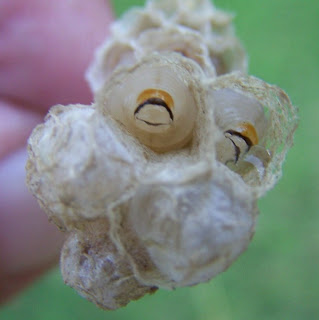Paper wasps feed abundantly on corn earworms, armyworms, tobacco hornworms, etc.

Paper wasps and hornets are social insects, living in colonies containing workers, queens and males.
 Fertilized queens occur in protected places such as houses and other structures, hollow logs, in stumps, under bark, in leaf litter, in soil cavities, etc. Queens emerge during the warm days of late April or early May, select a nest site and build a small paper nest in which eggs are laid. One egg is laid in each cell. As she adds more cells around the edge, eggs are deposited. Larvae in the center are older with the younger larvae further out. It is the cells at the rim of the nest which contain eggs. After eggs hatch, the queen feeds the young larvae. When larvae are ready to pupate, cells are covered with silk, forming little domes over the individual openings. Larvae pupate, emerging later as small, infertile females called "workers."
Fertilized queens occur in protected places such as houses and other structures, hollow logs, in stumps, under bark, in leaf litter, in soil cavities, etc. Queens emerge during the warm days of late April or early May, select a nest site and build a small paper nest in which eggs are laid. One egg is laid in each cell. As she adds more cells around the edge, eggs are deposited. Larvae in the center are older with the younger larvae further out. It is the cells at the rim of the nest which contain eggs. After eggs hatch, the queen feeds the young larvae. When larvae are ready to pupate, cells are covered with silk, forming little domes over the individual openings. Larvae pupate, emerging later as small, infertile females called "workers."
 Adult food consists of nectar or other sugary solutions such as honeydew and the juices of ripe fruits.
Adult food consists of nectar or other sugary solutions such as honeydew and the juices of ripe fruits.
 After being stung, immediately apply a poultice of meat tenderizer to the wound. If the sting is not deep, this will break down the components of the sting fluid, reducing the pain.
After being stung, immediately apply a poultice of meat tenderizer to the wound. If the sting is not deep, this will break down the components of the sting fluid, reducing the pain.

 Fertilized queens occur in protected places such as houses and other structures, hollow logs, in stumps, under bark, in leaf litter, in soil cavities, etc. Queens emerge during the warm days of late April or early May, select a nest site and build a small paper nest in which eggs are laid. One egg is laid in each cell. As she adds more cells around the edge, eggs are deposited. Larvae in the center are older with the younger larvae further out. It is the cells at the rim of the nest which contain eggs. After eggs hatch, the queen feeds the young larvae. When larvae are ready to pupate, cells are covered with silk, forming little domes over the individual openings. Larvae pupate, emerging later as small, infertile females called "workers."
Fertilized queens occur in protected places such as houses and other structures, hollow logs, in stumps, under bark, in leaf litter, in soil cavities, etc. Queens emerge during the warm days of late April or early May, select a nest site and build a small paper nest in which eggs are laid. One egg is laid in each cell. As she adds more cells around the edge, eggs are deposited. Larvae in the center are older with the younger larvae further out. It is the cells at the rim of the nest which contain eggs. After eggs hatch, the queen feeds the young larvae. When larvae are ready to pupate, cells are covered with silk, forming little domes over the individual openings. Larvae pupate, emerging later as small, infertile females called "workers." After being stung, immediately apply a poultice of meat tenderizer to the wound. If the sting is not deep, this will break down the components of the sting fluid, reducing the pain.
After being stung, immediately apply a poultice of meat tenderizer to the wound. If the sting is not deep, this will break down the components of the sting fluid, reducing the pain.





